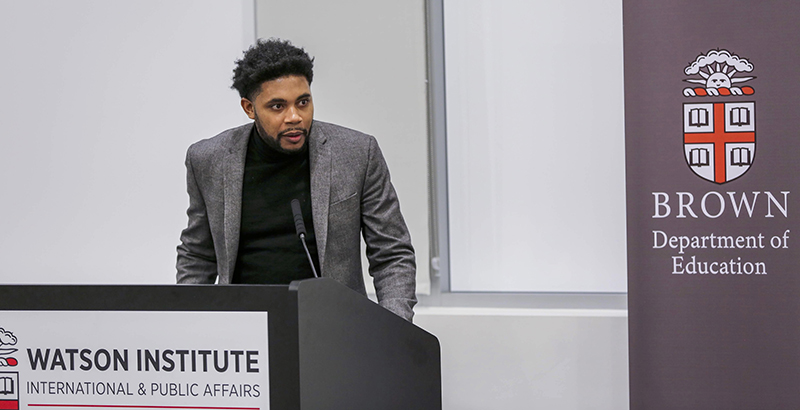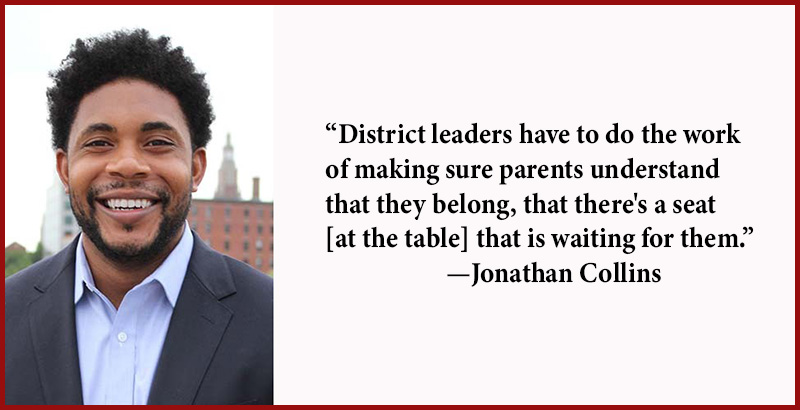74 Interview: Brown University’s Jonathan Collins on Why Getting Family Input into Spending $122B American Rescue Plan Key to Reopening Schools This Fall

Get essential education news and commentary delivered straight to your inbox. Sign up here for The 74’s daily newsletter.
U.S. schools have $122 billion coming their way after the passage of the American Rescue Plan. But accompanying the relief cash is a key responsibility: making decisions about how to spend it.
Jonathan Collins, assistant professor of education at Brown University, argues that students, parents and community stakeholders must have a seat — or Zoom box — at the metaphorical table as districts mull how to invest in pandemic recovery and long-term solutions.
Though the vast majority of schools nationwide now offer students at least some access to in-person learning, large shares of families have opted to keep their children learning from home. Experts are sounding the alarm on widespread “school hesitancy,” which in many cases has shifted away from worries for COVID-19 safety, and has instead landed on more fundamental issues such as the desire to avoid racism experienced in school or bypassing academic schedules that don’t accommodate student jobs.
Instilling confidence in parents to return their children to classrooms next fall will require active outreach and collaboration from districts, Collins told The 74.
“It’s going to be difficult to expect buy-in this fall if during the summer we don’t use this as an opportunity to have important and substantive dialogues.”
The Brown University researcher specializes in “deliberative democracy” — the back-and-forth conversations between officials and citizens that can steer decision making — in schools.
As public institutions, schools have a responsibility to engage the families they serve, he says. And this summer may well be the perfect opportunity to double down on those efforts.
“Everyone has their eyes and ears on what’s happening now with schools and reopening,” said Collins. “So it’s not going to take very much effort to get parents and students to want to talk about this. The most important thing is to just create opportunities for these conversations to happen.”
Washington, D.C., where officials are soliciting public input on how to spend American Rescue Plan dollars through a public survey, provides an early example.
The 74 sat down with Collins (outdoors, masked, at a coffee shop) to learn how school leaders can bring community members to the table and collaboratively decide how best to spend the incoming infusion of federal cash.
The conversation has been edited for length and clarity.
The 74: One specialty of yours is measuring the level of “democracy” in schools and districts. What does that mean exactly for a school to be more or less democratic?
Collins: There are different dimensions that we can look to. One more standard way is to look at their elections. Are they holding school board elections? Is the population of folks turning out to vote in the school board elections representative of the larger district?
The other direction that I’ve been pushing the literature to take more seriously is this idea of whether or not the leaders in the district take on democratic habits. Are they looking to identify and solve problems through discourse with community members and parents and students? Are they looking for a more collaborative form of governance? Or are they looking to mainly engage in administrative duties with an assumption that the expertise only lies with the folks who have the fancy titles?
A really democratic form of governance … brings in the voices of folks who are in the school buildings every day and increases our opportunity to solve these really complex and nuanced problems.
So now there’s all this relief money — $122 billion — going to schools. That means a lot of spending decisions. How can school leaders make sure that they’re bringing community input into that process?
The money coming in from the American Rescue Plan is the perfect example of why we need true substantive dialogue. Education policy scholars are rightfully warning us that we have to be very careful about how we spend this money, because there’s an impending fiscal cliff that could be created here. This money that’s coming into districts, it’s not permanent. It’s very temporary. So we need districts to be able to spend this money and utilize it effectively.
But it’s also important to say, “OK, given these limitations, what can we do?” So this is why it’s important for districts right now to be having these conversations with folks in their communities.
We have two different options here. We can see this money used in ways that fit what the experts say. Or we can use it in ways that fit what parents, students and community stakeholders say. Honestly, I think that the best route is going to be the latter.
The people who know how to best use these funds are the people that had to deal with remote learning for a year. The people who were thrown into uncertainty. The kids who had to deal with all of the consequences of everything that we experienced over the past year. These kids and their parents should be the main ones that we’re talking to when we’re having conversations about how to spend this new money that’s coming in.
What concrete steps or pieces of advice would you give to school leaders looking to bring community members into this process?
You want to have a multi-tiered approach. You want to begin with the parents and stakeholders who are going to be the most active and engaged. They are assets to the district who will help you bring new faces to the table.
But it’s also important to understand that everyone has their eyes and ears on what’s happening now with schools and reopening. So it’s not going to take very much effort to get parents and students to want to talk about this. The most important thing is to just create opportunities for these conversations to happen. And make sure that people know that these conversations are real.
So in practical terms, do you mean events like community forums and roundtables? What sort of opportunities could leaders create?
In my own research, I found that parents were really receptive to the idea of attending virtual meetings. Meetings that then solicited feedback and deliberation [were even better]. So my research finds evidence that this could work. It’s just a matter of districts and schools putting together a series of conversations to hash this out.
This does create extra work for districts. And so we should also be thinking about some of this American Rescue Plan money going to communication and dialogue. And making sure that we can have these kinds of forums in ways that are convenient and accessible for parents.

So some folks might look at this process and say, “That’s a lot of work.” But your research has shown that it’s worth it?
Yes. I find in my research that parents, especially parents of color, are very receptive to these reopening decisions being made through a public decision-making process, as opposed to just simply relying on the district leaders and the bureaucrats.
And right now, you need families on board. You need parents to be OK [returning] their kids to school. You need kids to be on board with still wearing masks. So it’s about making sure that you get all the ideas that you can from the parents and the students and stakeholders and making sure that they’re on board with the plan because this upcoming year is going to create a unique challenge.
Heading into the summer, virtually all states are relaxing their requirements on a lot of COVID-related safety measures. If we find ourselves in a place in the fall, where we have to put those measures back in place, we need everyone to understand the benefits of ensuring a school is safe. And you can’t do that without dialogue.
So for parents to be on board with returning to school this fall, they need to be part of the process of how to use this money that’s supposed to help schools recover from the pandemic?
Exactly. It’s going to be difficult to expect buy-in this fall if during the summer we don’t use this as an opportunity to have important and substantive dialogues.
What sort of pandemic-era school changes do you hope stick?
I do think the more frequent communication between teacher and parent is something that should stay in place.
It sounds odd, but [another key lesson is the importance of] keeping schools clean. It would be great if that sticks around.
Also aspects of virtual learning. Schools have been forced to innovate. For teachers, in particular, it’s been a heavy lift, but they’ve had to find new creative ways to use online resources and online communication to keep students engaged, learning and feeling like they’re a part of the school. There are lessons to be learned from them.
Anything that I haven’t asked about yet that I should have?
We talked about the idea of holding meetings and forums, which I think is useful. But I think it’s also going to be important to tap into a lot of the civic groups who’ve really stepped up and done a lot of heavy lifting over the course of the year.
Also it’s about looking at what new technologies have emerged that might make community engagement more feasible. … We’re still having to rely on online platforms to engage communities. We’re going to have to get very creative about how we bring parents in. Because a lot of parents aren’t used to that experience.
We have a lot of school leaders who write parents off, thinking that they don’t care about these processes. But what I’ve been finding is that a lot of parents just don’t believe that these are places where they belong, that the decision-making table really has a seat for them. School leaders and district leaders have to do the work of making sure parents understand that they belong, that there’s a seat that is waiting for them, should they choose to sit in it.
It’s not something that happens overnight. It’s something that takes constant effort: building relationships, maintaining relationships, dialogues, conversations, forums that actually result in changes. But you have to begin this process of helping parents understand that, not only do they have the right to be a part of these processes and decisions, that they’re invited and welcome. And that the school district and the decisions that they reach are going to be better when the parents are there.
Get stories like these delivered straight to your inbox. Sign up for The 74 Newsletter

;)

